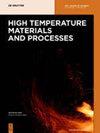Cr–Mo冷镦钢表面脱碳和氧化行为的表征
IF 1.5
4区 材料科学
Q4 MATERIALS SCIENCE, MULTIDISCIPLINARY
引用次数: 1
摘要
摘要采用光学显微镜、扫描电镜和电子背散射衍射等方法研究了Cr-Mo冷镦钢在不同温度下的表面脱碳和氧化特性。进一步分析了脱碳和氧化的竞争机制。结果表明,加热温度对钢试样的脱碳和氧化特性有较大影响。随着温度的升高,总脱碳层的深度增加。完全脱碳层在750 ~ 850℃之间显著,在800℃达到顶峰。氧化物厚度呈抛物线状增加,Cr2O3存在,抑制氧化。在700 ~ 950℃之间,氧化增重缓慢。氧化垢的主要结构是致密的Fe3O4层,抑制了脱碳。950℃时氧化速率加快,氧化垢中松散FeO层的比例超过66%,促进了脱碳。在bbb10,000℃时,表面脱碳率和氧化率同时提高。本文章由计算机程序翻译,如有差异,请以英文原文为准。
Characterization of surface decarburization and oxidation behavior of Cr–Mo cold heading steel
Abstract Herein, the surface decarburization and oxidation characteristics of Cr–Mo cold heading steel are investigated via optical microscopy, scanning electron microscopy, and electron backscatter diffraction under different temperatures. Furthermore, the competitive mechanisms of decarburization and oxidation are analyzed. The results indicate that the heating temperature considerably affects the decarburization and oxidation characteristics of the steel sample. With an increase in the temperature, the depth of the total decarburization layer increases. The fully decarburized layer is prominent between 750 and 850°C and culminates at 800°C. The oxide thickness parabolically increases, and Cr2O3 is present, which inhibits oxidation. Between 700 and 950°C, the oxidation weight gain is slow. The main structure of the oxide scale is the dense Fe3O4 layer, inhibiting decarburization. The oxidation rate increases at 950°C, and the proportion of loose FeO layer in the oxide scale exceeds 66%, promoting decarburization. At >1,000°C, the surface decarburization and oxidation rate simultaneously increase.
求助全文
通过发布文献求助,成功后即可免费获取论文全文。
去求助
来源期刊

High Temperature Materials and Processes
工程技术-材料科学:综合
CiteScore
2.50
自引率
0.00%
发文量
42
审稿时长
3.9 months
期刊介绍:
High Temperature Materials and Processes offers an international publication forum for new ideas, insights and results related to high-temperature materials and processes in science and technology. The journal publishes original research papers and short communications addressing topics at the forefront of high-temperature materials research including processing of various materials at high temperatures. Occasionally, reviews of a specific topic are included. The journal also publishes special issues featuring ongoing research programs as well as symposia of high-temperature materials and processes, and other related research activities.
Emphasis is placed on the multi-disciplinary nature of high-temperature materials and processes for various materials in a variety of states. Such a nature of the journal will help readers who wish to become acquainted with related subjects by obtaining information of various aspects of high-temperature materials research. The increasing spread of information on these subjects will also help to shed light on relevant topics of high-temperature materials and processes outside of readers’ own core specialties.
 求助内容:
求助内容: 应助结果提醒方式:
应助结果提醒方式:


